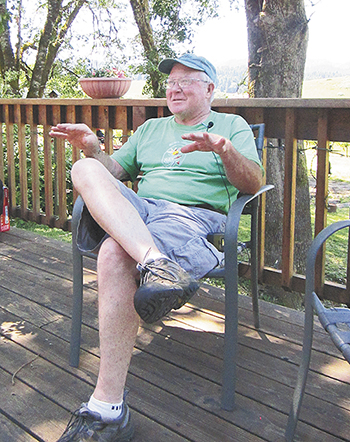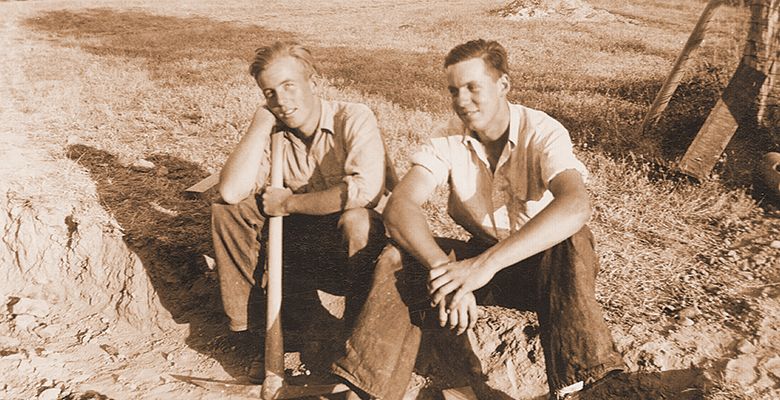Archiving Oregon
Linfield College captures story of state’s evolving wine industry
By Rachael Woody & Rich Schmidt
When Linfield College founded the Oregon Wine History Archive (OWHA) in 2011, the scope of the project was unspecified. Linfield — in McMinnville, the heart of the Willamette Valley wine region — had forged connections with some of the area’s wine pioneers, and their collections were the catalyst to begin the archive.
In order to include the complete narrative of Oregon wine, the OWHA staff quickly realized they needed to venture beyond the Willamette Valley and seek collections and stories from the state’s grape-growing regions in the Umpqua, Rogue and Columbia valleys. OWHA staff worked with the Oregon Wine Board for what became a multi-year project traveling the state’s wine regions, meeting with people in the local wine industry, filming interviews and securing documents, photographs and artifacts to augment the Oregon wine story.
Umpqua Valley was the first region visited, and on the last day the staff squeezed in three interviews with area winemakers, one of whom was with John Bradley, the late owner of Bradley Vineyards. Bradley passed away not long after the OWHA interview, and the sudden loss of this Elkton-area pioneer emphasized the importance of capturing these winemakers’ stories.

Bradley’s interview encapsulates a number of themes in interviews across the regions, including area identity, how winemakers entered the industry and where they see it evolving. Bradley Vineyards is located in the Elkton AVA.
As Bradley explained, “Elkton is at the north end of the Umpqua Valley. We are the cooler part of the Umpqua Valley. We are unique unto ourselves, because we have this little coastal influence — this little gorge that runs out to the coast. I think that it’s great we get some recognition for that … We’re deserving of our own moment here, I think.”
As with many Oregon wine pioneers, Bradley entered grapegrowing from a completely different field: construction. While many, Bradley included, didn’t start with immediate wine industry knowledge, they all shared in the confidence that growing wine grapes in Oregon would work.
“It’s like the whole industry of so many people came from so many different walks of life … It’s all a bunch of independent people and it’s like they knew they were right – what they were doing … You get up north [Willamette Valley] and you get the same thing. All the people, all the early-year people up there that are all very independent people from all walks of life, from all over the country come to Oregon to plant grapes.”
The fact that the number of Oregon wineries has increased dramatically in the last decade emphasizes the continued appeal to make Oregon wine.
Bradley, and others, have been quick to point out the hard work involved in the wine industry. Often winemakers are asked for advice from those interested in entering the industry, and frequently the winemakers’ answers are conservative and cautionary.
“It’s that whole romance thing, you know? … And when you’re out there at 5:30 in the morning spraying grapes, trying to keep powdery mildew at bay, you’re going ‘Yea, this is pretty romantic.’ It’s a lot of work and you can’t emphasize that enough to people who are saying ‘Oh, I think I’ll plant a vineyard.’ It is a lot of work.”
In just the 54 years since Richard Sommer planted Pinot Noir in Roseburg, the successful results from the hard work that Bradley and many others reference is evident. Oregon’s reputation for wine has grown. When speculating on Oregon wine industry’s potential for growth, Bradley describes conversations he and his family have had with people outside Oregon as an indication of further growth potential.
“Almost the first thing they say is, ‘Oh, Oregon wines, Oregon Pinot Noir.’ It used to be “Oh, Oregon, where it rains all the time.’ But, you know, that’s really changed. So, given that people are so aware of Oregon wines and sort of anxious to taste them, to experience Oregon wines — I think that we’ve not seen the end of our growth … People are looking for the Oregon wine experience, and I think we’re at a growth point, and I think it’s going to continue. I really do.”
People traveling here seeking the “Oregon wine experience” is proof of the impressive role the industry plays in the state, both economically and culturally. It was not that long ago that the state boasted fewer than 20 wineries; now there are more than 500, with an economic impact in the billions of dollars.
The story of the rise is at the heart of the OWHA’s mission, and hearing firsthand accounts from pioneers like Bradley — who invested themselves early, when success was far from a given — demonstrates the uniqueness of the narrative, and the critical importance of collecting it.
As Bradley poignantly stated, “I hope it’s not too late to scramble around and get this history put together and sort it out and, you know, I’m sure it’s not, but it takes someone to do that.”
For Bradley, and for all people who make up the Oregon wine industry, the OWHA will continue to capture their stories – the stories of Oregon wine.
To see the full John Bradley interview: http://digitalcommons.linfield.edu/owha_bradley_interview/1/








